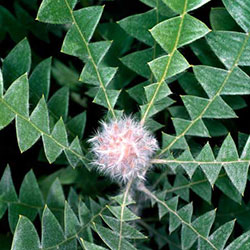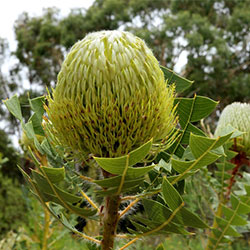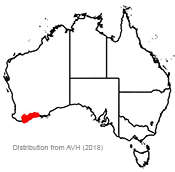Banksia baxteri
 |
 |
Baxter's Banksia, Bird's Nest Banksia
 Banksia baxteri, also known as 'Baxter's Banksia' and 'Bird's Nest Banksia', is a member of the family Proteaceae. It is endemic to Western Australia, and grows naturally in the nutrient-poor, sandy dunes from Albany on the coast up into the Stirling Range.
Banksia baxteri, also known as 'Baxter's Banksia' and 'Bird's Nest Banksia', is a member of the family Proteaceae. It is endemic to Western Australia, and grows naturally in the nutrient-poor, sandy dunes from Albany on the coast up into the Stirling Range.
Banksia baxteri grows as a shrub up to 4m high, with open branches spreading from a central stem. This species is highly valued for its ovoid, 40 mm wide lemon-yellow inflorescences, which grow at the ends of the branches within a rosette of leaves. These have been said to look like a bird's nest, hence the common name 'Bird's Nest Banksia'. Flowering usually occurs mid-Summer to Autumn (January to March), but can continue until well into May.
New foliage grows from the terminal tips, and is rust coloured, moderately hairy and soft. The mature leaves grow to 150 mm long, becoming stiff and dull green, with conspicuous triangular shaped lobes. Pruning back hard post flowering will encourage attractive new growth and flowers, and prevent the plant from becoming too straggly. Water sparingly in summer. If fertiliser is required, chose one with no phosphorus to prevent damage to the plant.
The fruit of Banksia baxteri is woody, with many of the old flower spikes of the inflorescence remaining on the plant. The seeds are held within hard capsules called follicles, which when mature are deep brown and velvety. Like many other Banksias this species holds its mature seed in the canopy until it is released by a trigger, commonly fire. The adult plant lacks a lignotuber and is killed by fire, relying on the germination of dropped seeds to grow a new plant in its place. The heat and smoke from the fire open the mature follicles, releasing the rounded, winged seed.
To simulate these conditions and open a Banksia baxteri follicle at home place the mature fruit into a warm oven (about 140º C) for around 15–20 minutes. The seed can then be removed with tweezers or gently shaken out of the open follicles. Germinating from seed is the most commonly used propagation method, with no pre-treatment required for successful germination. Banksia baxteri can also be grown from cutting easily, with no rooting hormone required.
Once established, Banksia baxteri has been shown to grow in full sun and under heavy frosts, with little to no damage observed to the foliage or flowers. This species needs very well drained, slightly acidic soil, with a pH of 5 to 6 for optimum growth. It has also been successfully grown in a porous, sandy substrate in concrete pipes, simulating the dune environment it grows in naturally.
Good drainage is especially important to prevent infection by Phytophthora cinnamomi, an introduced water-mould pathogen which causes rot in the roots of the plant. Banksia baxteri is very susceptible to infection. Minimising water around the base of the plant and using clean tools will help reduce this risk.
Rosemary Hulak, Volunteer Botanical Training Program Participant 2018
Name meaning: Banksia baxteriBanksia - named for Sir Joseph Banks, the first European to collect specimens of the genus in 1770 baxteri - named for William Baxter, an English botanical collector who made the first collection of the species |
References:
Australian National Herbarium. (2015). Information about Australia's Flora: Banksias – genus Banksia. Available at http://www.anbg.gov.au/banksia [Accessed 13 February 2018]
Australian Native Plants Society. (2016). Banksia. Available at http://anpsa.org.au/banksia.html [Accessed 13 February 2018]
CSIRO Publishing. (1999). Flora of Australia 17B: Proteaceae 3, Hakea to Dryandra. Melbourne, VIC. CSIRO Publishing.
George, A.S. (1996). The Banksia Book. Kenthurst, NSW, Australia. Kangaroo Press in association with the Society for Growing Australian Plants, NSW.
Holliday, I. and Watton. G. (1996). A Field Guide to Banksias. Sydney, NSW. Lansdowne Publishing.
Mccredie, T.A., Dixon, K.W. and Sivasithamparam, K. (1985). Variability in the Resistance of Banksia L.f. Species to Phytophthora cinnamomi Rands. Australian Journal of Botany 33(6): 629–637.
Bredell, P., Taylor, D. & Uwedo-Hampshire, R. (2018). Horticulturists, Australian National Botanic Gardens. Personal communication.
![An Australian Government Initiative [logo]](/images/austgovt_brown_90px.gif)

